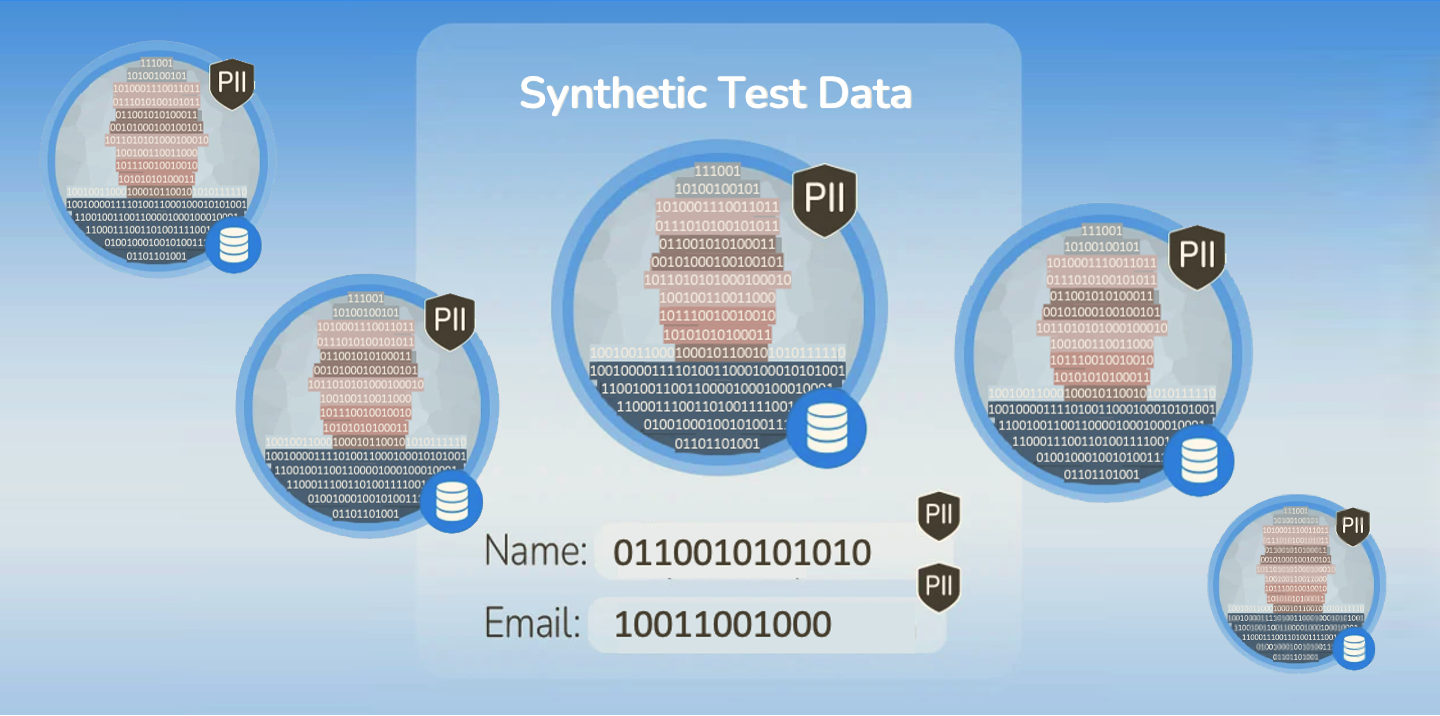Discover the key benefits of synthetic test data, and why it makes sense to include it among the test data management tools at your immediate disposal.
What is Synthetic Test Data?
Synthetic data generation refers to a dataset that has been artificially produced to mimic production data. Although synthetic data isn’t representative of real objects, events, or people, it can be realistic statistically, or mathematically. In the realm of testing, the use of synthetic test data can speed up test data provisioning, which is often a bottleneck to DevOps and software testing teams.
The main benefits of synthetic test data are that it can:
-
Reduce reliance on production data, which requires masking to protect Personally Identifiable Information (PII);
-
Augment production data where data is sparse, for example, when a certain sample requires real-life data from 1,000 customers, but the production data of 10 customers is all that’s available; and
-
Increase software testing efficiency, speed, and reliability.
In some cases, synthetic test data is preferred over production data for reasons of security and privacy compliance.
Synthetic Test Data Advantages
As detailed above, synthetic data creation can be invaluable to data testing and DevOps teams, if there isn’t enough relevant or complete production data to work with. Moreover, a synthetic dataset eliminates the cybersecurity and noncompliance risks of using real, sensitive data in testing environments. It’s also great for testing NEW applications, for which no production data exists. In this case, testers can match their requirements to the closest “look-alike” profiles available.
For test data management teams, it doesn’t matter whether the data is real or synthetic. What matters to them are the quality, balance, and bias within the data – and that the data is as “realistic” as possible. Synthetic test data enables greater data optimization and enrichment, for example:
-
Enhanced data quality
Real-world data can be prone to errors, inaccuracies, and biases that can negatively impact the reliability of your testing process. On the other hand, the ability to generate fake data increases data quality, variety, and balance. Synthetic data generation also allows you to automate a number of aspects to improve uniformity and quality, such as:
– Labeling data in a standardized way
– Deleting duplicate data
– Eliminating erroneous records
– Collating data from multiple sources (often in multiple formats) -
Increased scalability
The amount of reliable, complete, and high-quality data in real production datasets is often not enough for running meaningful software testing. Sometimes, defining the parameters for synthetic data generation is easier than deriving rules-based test data. As a result, augmenting real data with synthetic test data enables far greater scalability and flexibility for testing teams. -
Stronger data protection
The current standard for obfuscating and protecting sensitive data in testing environments is data masking. Although data masking tools are effective in keeping private data secure, they don’t completely eliminate risk. But those who synthesize data can keep sensitive or personal information safe. For example, development and testing teams can use synthetic patient data to test new healthcare applications quickly and securely.
Production vs Synthetic Test Data
Different testing needs and constraints call for different types of test data. Here are 3 key criteria to consider when deciding when to use production test data, and when to use synthetic test data.
-
Speed
Time constraints can influence what type of test data is ideal. Provisioning production test data can take days, or weeks without the proper test data management tools. On the other hand, synthetic test data can be generated in minutes, reducing the time needed for masking. And, with a self-service approach, virtually any stakeholder can learn how to create synthetic data on-demand. -
Cost
Enterprises must ask themselves what is an acceptable cost for preparing, managing, and archiving test data. If test data management is required for provisioning and storing production test data, enterprises must shoulder the costs of maintaining and customizing such a system. Conversely, it is possible to acquire synthetic data testing capabilities through more versatile and cost-effective platforms. (More on that later.) -
Compliance
It’s crucial to determine how sensitive the data within test datasets is. When test data is provisioned from production, all Personally Identifiable Information (PII) must be obfuscated, otherwise it exposes the organization to non-compliance penalties and data breaches. Synthetic test data generation guarantees a complete absence of PII in the test dataset, and total compliance with all data protection laws, such as GDPR, CPRA, PCI DSS, HIPAA, and more.
Synthetic Test Data Generation
Different testing needs and constraints call for different types of test data generation solutions. Here are 3 key criteria to consider when deciding when to use production test data, and when to use synthetic test data.
-
Determine software testing and compliance requirements
The first step is defining what kinds of data is needed for a given test. You’d also want to identify relevant privacy restraints, compliance standards, or security policies that provisioners should be aware of. The important thing is to have a large enough test data management toolbox, where synthetic test generation is readily available. -
Choose the right synthetic test data generation model
There are a variety of synthetic test data generation models, such as the Monte Carlo method, generative AI synthetic data techniques – including Variational Auto-Encoders (VAEs) and Generative Adversarial Networks (GANs) – as well as various diffusion models. Different models serve distinct purposes, and require different levels of technical expertise and computational resources. Make sure your test data management platform’s got you covered. -
Create the initial dataset
Most of the synthetic data generation techniques listed above require real data samples. It’s important to choose high-quality data from the production database, because the reliability of this sample will determine the quality of the resulting synthetic test data – or whether to use test data masking. -
Build and train the algorithm
The next step is to construct the model architecture and train it using the production data sample. -
Evaluate your synthetic test data
Before employing synthetic test data at scale, you’ll want to evaluate its quality and ability to produce results similar to the original data. You can achieve this via manual inspection, statistical analysis, and training runs.
AI/ML-based vs Rules-Based Synthetic Test Data
2 of the most common methods for generating synthetic test data are deep generative models and rules-based test data generation.
Deep generative models rely on Artificial Intelligence/Machine Learning algorithms which have been “trained” (on real data) to generate rich, realistic synthetic data that adheres to the same structure and content. A rules-based approach generates synthetic test data according to specific parameters defined by data engineers and data analysts.
Simplifying Synthetic Test Data Generation with Business Entities
There’s a new way to generate synthetic test data quickly and reliably, without the cost burden of a standalone test data management system. The entity-based test data management approach provides a comprehensive suite of test data management softwares to support rapid CI/CD pipelines in complex data environments.
When sufficient data is unavailable, or when the production dataset is too small for application testing, the solution provisions synthetic test data by business entity, providing testing and DevOps teams with high-quality and highly reliable fake test data.
Entity-based test data generation is a game-changer for testing and DevOps teams, which require high-quality, reliable, and on-demand test data. A business entity approach is the key to innovation, continuous development, and legacy application modernization.














